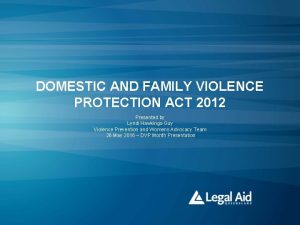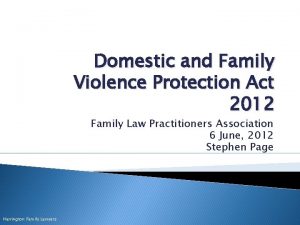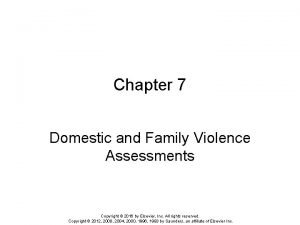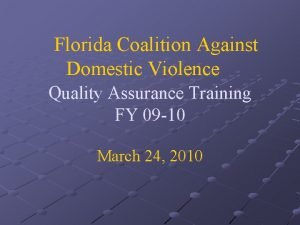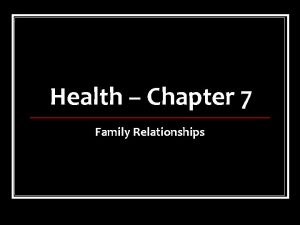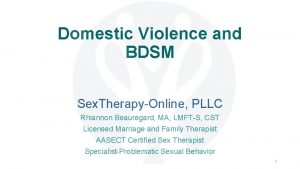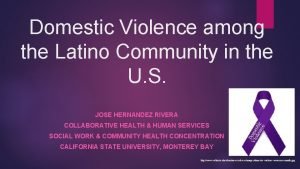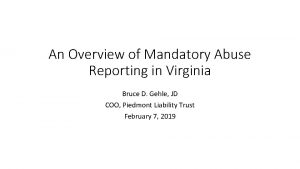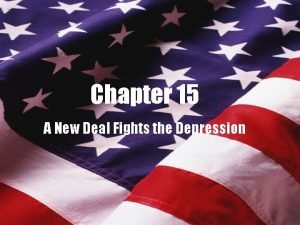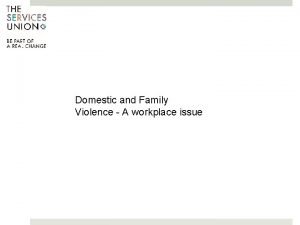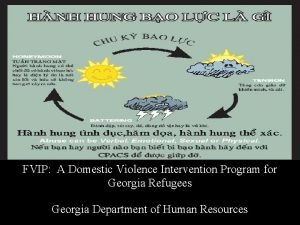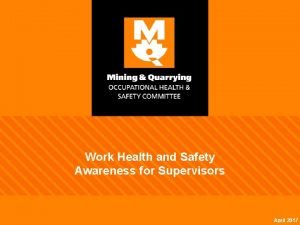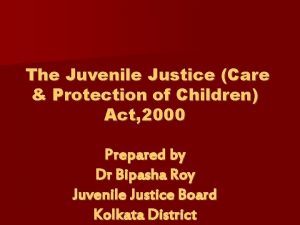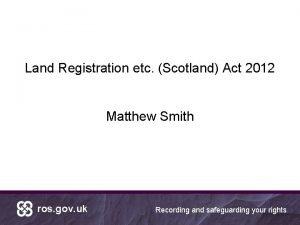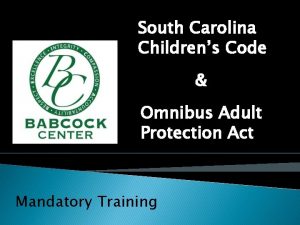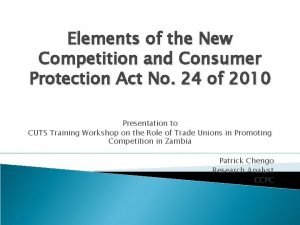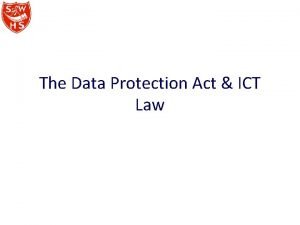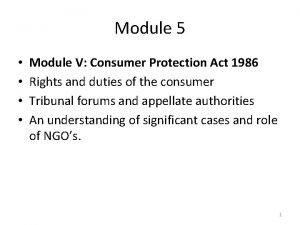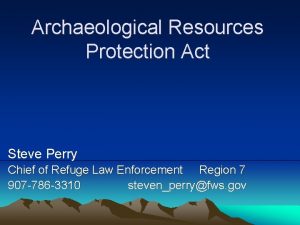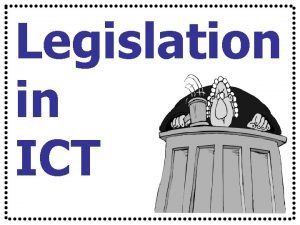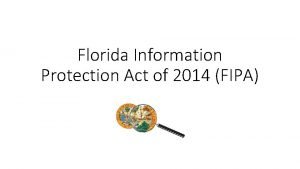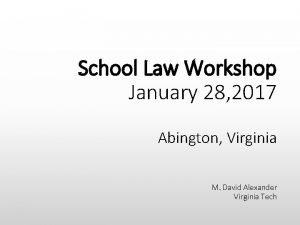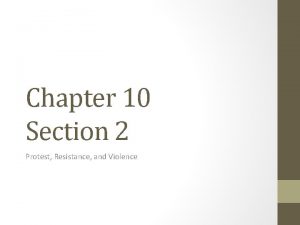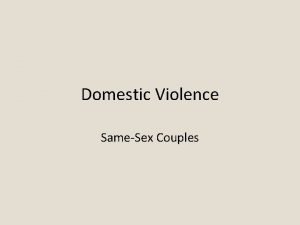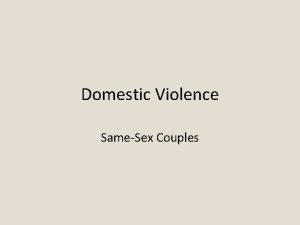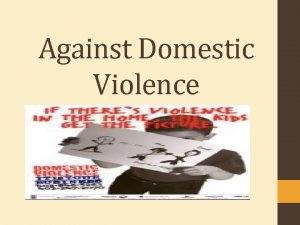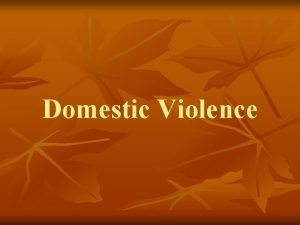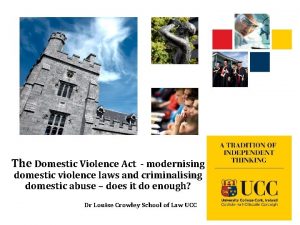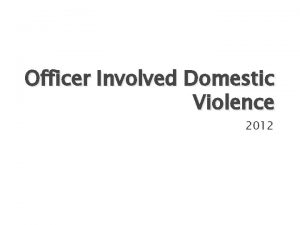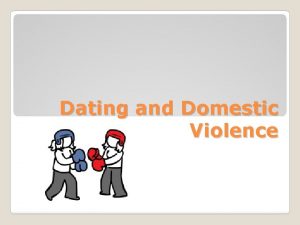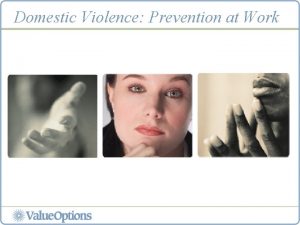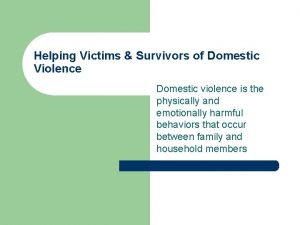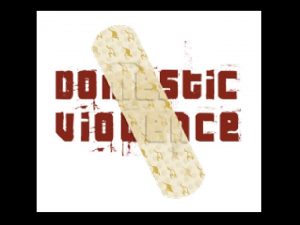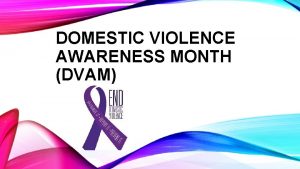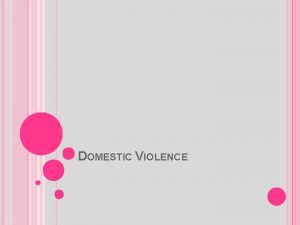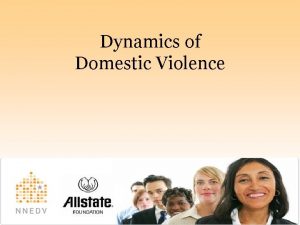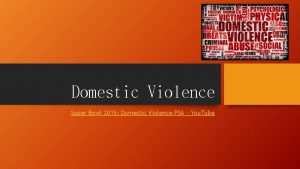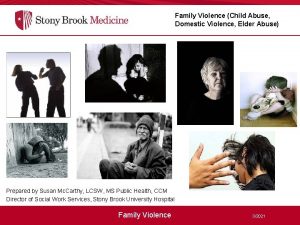Domestic and Family Violence Protection Act 2012 Family











































- Slides: 43

Domestic and Family Violence Protection Act 2012 Family Law Practitioners Association 6 June, 2012 Stephen Page Harrington Family Lawyers

Harrington Family Lawyers

Commences 17 September � Last Act of the Bligh government � Passed with support of the LNP � Forms and training still to occur � Unknown whether services that were to be funded under the Bligh government, e. g. , perpetrator programs, are to be funded under LNP Harrington Family Lawyers

Long title “An Act to provide for protection of a person against violence committed or threatened by someone else if a relevant relationship exists between the persons, and to make amendments of the Criminal Code, the Evidence Act 1977, the Police Powers and Responsibilities Act 2000 and the Police Powers and Responsibilities Regulation 2000 for particular purposes, and to make minor or consequential amendments of this Act and other legislation as stated in a schedule”. Harrington Family Lawyers

Preamble “In enacting this Act, the Parliament of Queensland recognises the following— 1 Australia is a party to the following instruments— • Universal Declaration of Human Rights • United Nations Declaration on the Elimination of Violence Against Women • United Nations Convention on the Rights of the Child • United Nations Principles for Older Persons 2 Living free from violence is a human right and fundamental social value. 3 Domestic violence is a violation of human rights that is not acceptable in any community or culture and traditional or cultural practices can not be relied upon to minimise or excuse domestic violence. 4 Domestic violence is often an overt or subtle expression of a power imbalance, resulting in one person living in fear of another, and usually involves an ongoing pattern of abuse over a period of time. 5 Domestic violence can have serious impacts on people who experience it, including physical, emotional and psychological harm, and can result in death. 6 Perpetrators of domestic violence are solely responsible for their use of violence and its impacts on other people. 7 Domestic violence is most often perpetrated by men against women with whom they are in an intimate partner relationship and their children; however, anyone can be a victim or perpetrator of domestic violence. 8 Domestic violence is a leading cause of homelessness for women and children. 9 Children who are exposed to domestic violence can experience serious physical, psychological and emotional harm. 10 Behaviour that constitutes domestic violence can also constitute a criminal offence. ” Harrington Family Lawyers

Main objects: section 3 “(1) The main objects of this Act are— (a) to maximise the safety, protection and wellbeing of people who fear or experience domestic violence, and to minimise disruption to their lives; and (b) to prevent or reduce domestic violence and the exposure of children to domestic violence; and (c) to ensure that people who commit domestic violence are held accountable for their actions. (2) The objects are to be achieved mainly by— (a) allowing a court to make a domestic violence order to provide protection against further domestic violence; and (b) giving police particular powers to respond to domestic violence, including the power to issue a police protection notice; and (c) imposing consequences for contravening a domestic violence order or police protection notice, in particular, liability for the commission of an offence. ” Harrington Family Lawyers

Principles: section 4 “(1) This Act is to be administered under the principle that the safety, protection and wellbeing of people who fear or experience domestic violence, including children, are paramount. (2) Subject to subsection (1), this Act is also to be administered under the following principles— (a) people who fear or experience domestic violence, including children, should be treated with respect and disruption to their lives minimised; (b) perpetrators of domestic violence should be held accountable for their use of violence and its impact on other people and, if possible, provided with an opportunity to change; (c) if people have characteristics that may make them particularly vulnerable to domestic violence, any response to the domestic violence should take account of those characteristics; (d) in circumstances in which there are conflicting allegations of domestic violence or indications that both persons in a relationship are committing acts of violence, including for their self-protection, the person who is most in need of protection should be identified; (e) a civil response under this Act should operate in conjunction with, not instead of, the criminal law. ” Harrington Family Lawyers

Change of test 1989 Act 1. Domestic relationship 2. An act or number of acts of domestic violence 3. Further acts likely or threat likely to be carried out Harrington Family Lawyers

Change of test: 2012 Act 1. Relevant relationship 2. An act or a number of acts of domestic violence 3. Protection order is necessary or desirable to protect aggrieved from domestic violence Harrington Family Lawyers

Step 1: Relevant relationships � Intimate � Family � Informal personal care � Spousal now incorporated under intimate personal Harrington Family Lawyers

Intimate personal relationships � Spousal relationships � Engagement relationships � Couple relationships Harrington Family Lawyers

Spousal relationships � Wider � Now includes “former parents” e. g. surrogacy birth mother � Wider definition of “parent” Harrington Family Lawyers

Parent: s. 16 (a) the child’s mother or father; and (b) anyone else, other than the chief executive (child protection), having or exercising parental responsibility for the child. (2) However, a parent of a child does not include— (a) a person standing in the place of a parent of the child on a temporary basis; or (b) an approved foster carer for the child; or (c) an approved kinship carer for the child. (3) A parent of an Aboriginal child includes a person who, under Aboriginal tradition, is regarded as a parent of the child. (4) A parent of a Torres Strait Islander child includes a person who, under Island custom, is regarded as a parent of the child. (5) In this section— ◦ approved foster carer see the Child Protection Act 1999, schedule 3. ◦ approved kinship carer see the Child Protection Act 1999, schedule 3. ” Harrington Family Lawyers

Example � Bob and Martha have a child, Billy � Family Court order: parental responsibility to Bob, Bob’s sister Penny, Penny’s partner veronica � Bob, Martha, Penny, Veronica are “parents” � Martha commits domestic violence to Veronica � Veronica may be able to obtain an order Harrington Family Lawyers

Engagement � Engaged Act Harrington Family Lawyers or betrothed- no change to 1989

Couple relationship � Are or were a couple � Same or different gender � More than mere dating � Concept of “enmeshment” removed � Even if all the examples are found not to have happened, the relationship may still exist Harrington Family Lawyers

Couple relationship � Examples of the circumstances of the relationship: � the degree of trust between the persons � the level of each person’s dependence on, and commitment to, the other person � the length of time for which the relationship has existed or did exist � the frequency of contact between the persons � the degree of intimacy between the persons Harrington Family Lawyers

Couple relationship Also consider these points: � whether the trust, dependence or commitment is or was of the same level � whether 1 of the persons is or was financially dependent on the other � whether the persons jointly own or owned any property � whether the persons have or had joint bank accounts; � whether the relationship involves or involved a relationship of a sexual nature � whether the relationship is or was exclusive Harrington Family Lawyers

Family relationship � No change to the 1989 Act � Limitations on who is in the family remain Harrington Family Lawyers

Informal care relationship � No change to the 1989 Act Harrington Family Lawyers

Step 2: Domestic violence � Big change to the definition Harrington Family Lawyers

Domestic violence: 1989 Act � Wilful injury to the other � Wilful damage to the property of the other � Harassment � Intimidation � Indecent behaviour to the other without the other’s consent � Threats to do any of these Harrington Family Lawyers

Domestic violence: 2012 Act � Physically abusive � Sexually abusive � Emotionally abusive � Psychologically abusive � Economically abusive � Threatening � Coercive � Any other way controls or dominates the second person and causes the second person to fear for the second person’s safety or wellbeing or that of someone else Harrington Family Lawyers

Examples of domestic violence conduct � � � � � causing personal injury to a person or threatening to do so coercing a person to engage in sexual activity or attempting to do so damaging a person’s property or threatening to do so depriving a person of the person’s liberty or threatening to do so threatening a person with the death or injury of the person, a child of the person, or someone else threatening to commit suicide or self-harm so as to torment, intimidate or frighten the person to whom the behaviour is directed causing or threatening to cause the death of, or injury to, an animal, whether or not the animal belongs to the person to whom the behaviour is directed, so as to control, dominate or coerce the person unauthorised surveillance of a person unlawfully stalking a person Harrington Family Lawyers

Step 3: Necessary or desirable � Not “likely” � Consider the principles � Was a voluntary intervention order made? Harrington Family Lawyers

Who is protected? � Aggrieved � Associates � Children Harrington Family Lawyers

Children � Of the aggrieved � Usually lives with the aggrieved � On a regular or ongoing basis Harrington Family Lawyers

Ex parte temporary protection orders � Is the order necessary or desirable to protect the aggrieved, or another person named in the application, from domestic violence? Harrington Family Lawyers

Consent orders � There is a consent of the parties to the making of an order � Or the parties do not oppose the making of the order � The relevant relationship exists between the aggrieved and the respondent � Court does not need to be satisfied that there have been acts of domestic violence Harrington Family Lawyers

Consent orders � Can be without admission � Ordinarily cannot be made with police application unless aggrieved is at court � Court can refuse to make order if it may pose a risk to the safety of an aggrieved, any named person, or any child affected by the order Harrington Family Lawyers

Associates � Necessary Harrington Family Lawyers or desirable that they be protected

Protecting children � Naming the child in the order is necessary or desirable to protect the child from – � Associated domestic violence; or � Being exposed to domestic violence committed by the respondent. � Removal of “likely” � If contested, DOCS must be notified � Condition includes not exposing child to domestic violence Harrington Family Lawyers

Protecting children � No contact with children � Only to the extent necessary for the child’s safety, protection and wellbeing � Unborn children to be protected Harrington Family Lawyers

Child exposed to domestic violence � child sees � hears domestic violence � otherwise experiences the effects of domestic violence. Harrington Family Lawyers

Examples of exposure � overhearing threats of physical abuse � overhearing repeated derogatory taunts, including racial taunts � experiencing financial stress arising from economic abuse � seeing or hearing an assault � comforting or providing assistance to a person who has been physically abused � observing bruising or other injuries of a person who has been physically abused � cleaning up a site after property has been damaged � being present at a domestic violence incident that is attended by police officers Harrington Family Lawyers

Ouster orders � � � � Whether the aggrieved any child living with the aggrieved can continue to live safely in the residence if the ouster condition is not made; The desirability of preventing or minimising disruption to the aggrieved any child living with the aggrieved, including by minimising disruption to their living arrangements allowing them to continue, or return, to live in the residence; The importance of the aggrieved any child living with the aggrieved being able to maintain social connections and support that may be disrupted or lost if they can not live in the residence; The need to ensure continuity and stability in the care of any child living with the aggrieved; The need to allow child care arrangements, education, training and employment of the aggrieved any child living with the aggrieved to continue without interruption; The particular accommodation needs of the aggrieved any child who may be affected by the ouster condition; The particular accommodation needs of the respondent. Harrington Family Lawyers

S. 68 R Family Law Act � 21 day freeze of family law contact orders � MUST be considered by Magistrates in making or varying orders Harrington Family Lawyers

Police protection notices � Cool down provisions � Accommodation issues Harrington Family Lawyers

Court proceedings � UCPR applies in many respects � Costs likely to be limited against aggrieveds Harrington Family Lawyers

Protected witnesses � Aggrieved � Child � Relative � Associate Harrington Family Lawyers

Protected witnesses � Must consider (mandatory for children): � evidence outside the courtroom through an AV link � Recorded evidence outside the courtroom and replayed in court � Screen or one way glass � Respondent in another room with an AV link � A support person; � Accommodate the protected witness in such a way to minimise his or her distress if he or she has a physical or mental disability � Any other alternative arrangement � No or limited cross-examination if respondent is selfacting Harrington Family Lawyers

Penalties � Increased: $6000 or 2 years � If offence in the last 5 years: maximum is $12000 or 3 years � Voluntary treatment orders Harrington Family Lawyers

White Ribbon Day – 25 November White Ribbon is the largest international male-led campaign to end violence against women. Change It. Wear It. Swear It. • • • Become an ambassador Host an event Wear a white ribbon or wristband Swear online at myoath. com. au Share on Facebook, Linked. In and Twitter
 Domestic and family violence protection act 2012
Domestic and family violence protection act 2012 S68r family law act
S68r family law act Routine, universal screening for domestic violence means
Routine, universal screening for domestic violence means Florida coalition against domestic violence
Florida coalition against domestic violence The three r's for stopping domestic violence
The three r's for stopping domestic violence Domestic violence kink
Domestic violence kink Domestic violence in the hispanic community
Domestic violence in the hispanic community Virginia mandatory reporting law domestic violence
Virginia mandatory reporting law domestic violence Antecedent passion
Antecedent passion Soil conservation and domestic allotment act
Soil conservation and domestic allotment act Soil conservation and domestic allotment act
Soil conservation and domestic allotment act Soil conservation and domestic allotment act
Soil conservation and domestic allotment act Family violence intervention program atlanta
Family violence intervention program atlanta Adolescent family violence program
Adolescent family violence program Workplace problems
Workplace problems Fvip georgia
Fvip georgia Work health and safety act 2012 sa
Work health and safety act 2012 sa Act 1 act 2 act 3
Act 1 act 2 act 3 Child protection and toy safety act
Child protection and toy safety act Care and protection of children act
Care and protection of children act Handling information in health and social care
Handling information in health and social care Child care and protection act 3 of 2015
Child care and protection act 3 of 2015 Hearth act of 2012
Hearth act of 2012 Land registration etc scotland act 2012
Land registration etc scotland act 2012 District forum in consumer protection act
District forum in consumer protection act Bbc bitesize data protection act
Bbc bitesize data protection act Omnibus adult protection act
Omnibus adult protection act Conclusion of consumer rights
Conclusion of consumer rights Data protection act teach ict
Data protection act teach ict Objectives of consumer rights
Objectives of consumer rights Archaeological resources protection act
Archaeological resources protection act Aedilitian actions
Aedilitian actions Rights of consumer protection act, 1986
Rights of consumer protection act, 1986 Which is a nonrenewable resource? soil fish wood coal
Which is a nonrenewable resource? soil fish wood coal Data protection act 1998 ict
Data protection act 1998 ict Florida information protection act of 2014
Florida information protection act of 2014 Paul d coverdell teacher protection act
Paul d coverdell teacher protection act Child protection reform amendment act 2017
Child protection reform amendment act 2017 Gandhi king and mandela what made non-violence work dbq
Gandhi king and mandela what made non-violence work dbq Chapter 9 resolving conflicts and preventing violence
Chapter 9 resolving conflicts and preventing violence Chapter 27 anger aggression and violence
Chapter 27 anger aggression and violence Chapter 10 section 2 protest resistance and violence
Chapter 10 section 2 protest resistance and violence Chapter 9 resolving conflicts and preventing violence
Chapter 9 resolving conflicts and preventing violence Rising tide chapter
Rising tide chapter
